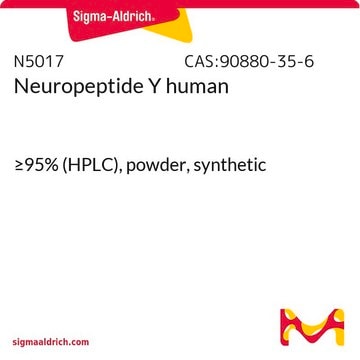Empfohlene Produkte
Biologische Quelle
synthetic (organic)
Qualitätsniveau
Beschreibung
RGD Peptide for Cell Adhesion, 5 mg
Sterilität
electron beam irradiated
Assay
≥95% (HPLC)
Form
powder
Methode(n)
tissue culture: suitable
Versandbedingung
wet ice
Lagertemp.
2-8°C
InChI
1S/C98H174N34O30/c1-48(2)31-60(84(151)120-56(79(100)146)22-17-27-107-96(101)102)124-86(153)62(33-50(5)6)126-88(155)64(35-52(9)10)128-89(156)65(36-53(11)12)127-87(154)63(34-51(7)8)125-85(152)61(32-49(3)4)123-83(150)59(24-19-29-109-98(105)106)122-91(158)67(44-133)119-76(142)42-113-73(139)39-111-72(138)38-112-74(140)40-114-82(149)58(21-15-16-26-99)121-92(159)69(46-135)130-93(160)68(45-134)129-80(147)54(13)116-94(161)71-25-20-30-132(71)95(162)70(47-136)131-90(157)66(37-78(144)145)118-77(143)43-115-81(148)57(23-18-28-108-97(103)104)117-75(141)41-110-55(14)137/h48-54,56-71,133-136H,15-47,99H2,1-14H3,(H2,100,146)(H,110,137)(H,111,138)(H,112,140)(H,113,139)(H,114,149)(H,115,148)(H,116,161)(H,117,141)(H,118,143)(H,119,142)(H,120,151)(H,121,159)(H,122,158)(H,123,150)(H,124,153)(H,125,152)(H,126,155)(H,127,154)(H,128,156)(H,129,147)(H,130,160)(H,131,157)(H,144,145)(H4,101,102,107)(H4,103,104,108)(H4,105,106,109)/t54-,56-,57-,58-,59-,60-,61-,62-,63-,64-,65-,66-,67-,68-,69-,70-,71-/m0/s1
InChIKey
DULMZMHLQQZGPY-ACFXXXONSA-N
Verwandte Kategorien
Anwendung
Use these procedures as a guideline to determine the optimal coating conditions for the culture system of coice. To maintain sterility, perform all operations in a laminar flow hood. Two options are provided:
Procedure A
1. Remove cap and add 5 ml of serum-free medium or PBS to the bottle.
2. Replace cap and vortex contents vigorously. Ensure that the PEPTITE-2000 is completely solubilized. The solution will remain slightly hazy.
3. Transfer desired volume of solution from the bottle to a dilution vessel. Dilute to desired concentration using serum-free medium or PBS. A typical working concentration may range from 0.1 to 10 μg/ml.
4. Add appropriate amount of diluted material to culture surface.
5. Incubate at room temperature or 37 °C, covered, for 1-2 hours.
6. After incubation, aspirate remaining material.
7. Rinse plates carefully with water and avoid scratching bottom surface of plates.
8. Plates are ready for use. They may also be stored at 2-8 °C damp or air dried if sterility is maintained.
9. Store remaining solubilized PEPTITE-2000 at 2 to 10 °C.
Additional note: Include divalent cations (Calcium, Magnesium, or Manganese) in cell attachment solution to obtain optimum cell binding.
Procedure B
1. Remove cap and add 5 ml of sterile 70% Ethanol
2. Replace cap and vortex contents. Ensure that the PEPTITE-2000 is completely solubilized.
3. Transfer desired volume of solution from the bottle to a dilution vessel. Dilute to the desired concentration using 70% Ethanol. Concentrations from 0.1 to 10 μg/ml should be tested.
4. Add appropriate amount of diluted material to culture surface.
5. Leave the coated container, uncovered, in a laminar flow hood until the wells are dry.
6. Rinse plates carefully with water and avoid scratching bottom surface of plates.
7. Plates are ready for use.
8. Store remaining solubilized PEPTITE-2000 at 2-10 °C.
- paramagnetic beads prior to incorporation with embryonic stem cells
- Corning Transwell polycarbonate membrane inserts for promoting cell attachment
- tosyl-activated magnetic beads in human colonic epithelial cells (HT-29) for binding experiments
- gold nanorods
Leistungsmerkmale und Vorteile
Sonstige Hinweise
Qualität
Rechtliche Hinweise
Lagerklassenschlüssel
11 - Combustible Solids
WGK
WGK 3
Flammpunkt (°F)
Not applicable
Flammpunkt (°C)
Not applicable
Analysenzertifikate (COA)
Suchen Sie nach Analysenzertifikate (COA), indem Sie die Lot-/Chargennummer des Produkts eingeben. Lot- und Chargennummern sind auf dem Produktetikett hinter den Wörtern ‘Lot’ oder ‘Batch’ (Lot oder Charge) zu finden.
Besitzen Sie dieses Produkt bereits?
In der Dokumentenbibliothek finden Sie die Dokumentation zu den Produkten, die Sie kürzlich erworben haben.
Unser Team von Wissenschaftlern verfügt über Erfahrung in allen Forschungsbereichen einschließlich Life Science, Materialwissenschaften, chemischer Synthese, Chromatographie, Analytik und vielen mehr..
Setzen Sie sich mit dem technischen Dienst in Verbindung.







